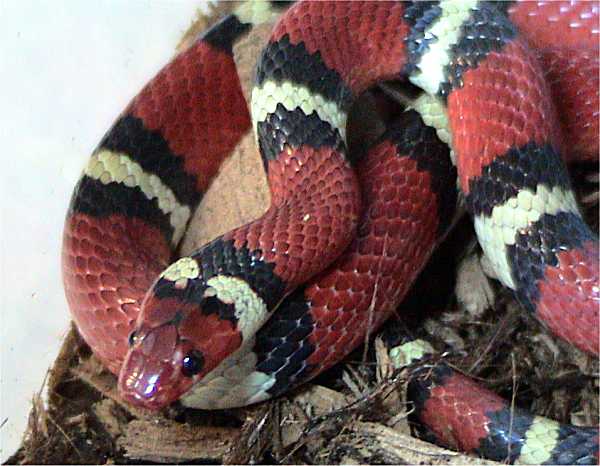|
| 질의: small white | 결과: 1664번째/2237 | |
Scarlet Kingsnake (Lampropeltis triangulum elapsoides) - Wiki
| 제목: | Scarlet Kingsnake (Lampropeltis triangulum elapsoides) - Wiki
| |

| 해상도: 600x466
파일크기: 40217 Bytes
등록시간: 2007:08:14 15:39:41
|
Scarlet Kingsnake
From Wikipedia, the free encyclopedia
[Photo] Scarlet King snake, Lampropeltis triangulum elapsoides. Photographer: User:Dawson http://en.wikipedia.org/wiki/User:Dawson
The Scarlet Kingsnake (Lampropeltis triangulum elapsoides) is a type of king snake that is found in the Eastern portion of the United States, particularly Florida. It is a subspecies of the milk snake Lampropeltis triangulum. It is significantly smaller than some of the other king snakes, usually well under 20 inches long.
Nonvenomous
Abundance: More common than previously thought. This is due, in part, because of its subterranean lifestyle and is seldom seen.
Size: Adults are 14-20inches and the record is ~28"
Habitat: Pine flatwoods, wet prairie hammocks, bottomland, mixed hardwood, upland pine forests, and sandhills.
Prey: Snakes, small rodents, lizards and skinks
Reproduction: lays 2-9 eggs which hatch in late summer.
The snake has a tri-color pattern of black, red, and yellow bands that mimic the venomous coral snake. A method to help differentiate between venomous and non venomous tri-color snakes in North America is found in the popular phrases "red on yellow, kill a fellow; red on black venom lack" or "If red touches yellow, you're a dead fellow; if red touches black, you're alright, Jack" and "Red and black is a friend of Jack".
While the phrases can be helpful in North America to partially identify a certain amount of risk with the venomous coral snakes they should not be used as a means of identification. If "red touches black" it does not necessarily mean you are dealing with a non venomous snake and it certainly does not necessarily mean you are dealing with a scarlet kingsnake. Be advised that the "phrases" are not accurate outside of North America. Other localities have venomous snakes where the red and black touch - and even within North America there are other snake species besides the Scarlet Kingsnake which are not venomous and have similar markings. Do not handle snakes at all if you are not sure of the identification and or are not experienced in doing so.
Juvenile specimens of this snake often have rings that look more "off white" than yellow.
Scarlet kingsnakes spend a lot of their time hiding under cover. Loose bark on rotting pine trees is a favorite place for them to hide. It is in these places that they find a steady supply of one of their favorite foods, skinks.
http://en.wikipedia.org/wiki/Scarlet_Kingsnake
| The text in this page is based on the copyrighted Wikipedia article shown in above URL. It is used under the GNU Free Documentation License. You may redistribute it, verbatim or modified, providing that you comply with the terms of the GFDL. |
|
댓글 |
|---|
| | 손님 |
|
SCARLET KING SNAKE
SCIENTIFIC CLASSIFICATION
FAST FACTS
FUN FACTS
ECOLOGY & CONSERVATION
BIBLIOGRAPHY
MENU - SQUAMATA
SCIENTIFIC CLASSIFICATION
COMMON NAME: scarlet king snake, scarlet milk snake, scarlet snake
KINGDOM: Animalia
PHYLUM: Chordata
CLASS: Reptilia
ORDER: Squamata
FAMILY: Colubridae
GENUS SPECIES: Lampropeltis (shining, beautiful scales) triangulum elapsoides
FAST FACTS
DESCRIPTION: Red, black, and yellow rings around entire body; red and yellow rings are both surrounded by black rings (the red and yellow rings never touch); red nose; ventral pattern same as dorsal
SIZE: 35.5-50.8 cm (14-20 inches) in length; maximum recorded length is 68.5 cm (27 inches)
WEIGHT: Average 1270 g (2.77 lb.)
DIET: Small mammals, eggs, and other reptiles (usually anoles and chameleons) including snakes
INCUBATION: 45-65 days
CLUTCH SIZE 2-9 eggs
SEXUAL MATURITY: 2 years
LIFE SPAN: 10-15 years
RANGE: Throughout Florida and from eastern Louisiana to southern New Jersey
HABITAT: Pinelands, hardwood hammocks, prairies, cultivated fields, and suburban areas |
| | payton |
|
| does anyone no anything about this creature |
| | payton |
|
| does anyone no anything about this creature |
^o^
동물그림창고 똑똑전화 누리집
^o^
|
|
|